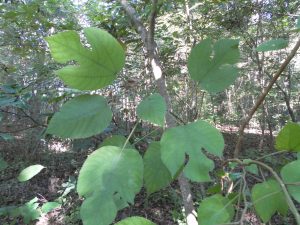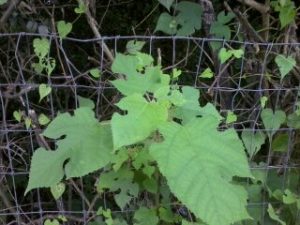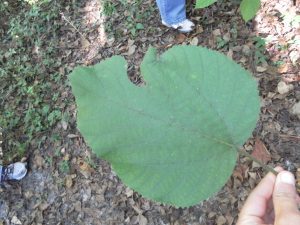Broussonetia papyrifera (Paper mulberry)

Photograph by J. Baniszewski
Broussonetia papyrifera is a member of the Moraceae family and is commonly referred to as paper mulberry (MacDonald et al. 2008). It is not native to Florida and although it was brought to the United States as an ornamental tree, it grows vigorously where it has established in natural communities and can displace native plant species (MacDonald et al. 2008). Paper mulberry is native to Japan and Taiwan and has been used to make paper or cloth (MacDonald et al. 2008). Currently, paper mulberry can be found throughout the Southeastern United States from Texas to Florida and northward to Illinois and Massachusetts (MacDonald et al. 2008).

Paper mulberry is sometimes considered to be a shrub, but is typically described as a tree and can grow to be 30 feet tall (MacDonald et al. 2008). The bark is pale brown in color, smooth and may have slight groove marks. The leaves can be 3 to 10 inches long and are alternate with a pubescent underside (MacDonald et al. 2008). Leaf shape varies with size. Larger leaves are cordate and generally have deep lobes. Smaller leaves are ovate with pointed tips and serrate margins (MacDonald et al. 2008). The tree contains a milky sap that can be seen oozing from the stem if leaves are pulled off or the stem is injured or cut in some way (MacDonald et al. 2008). Because B. papyrifera is deciduous, it has stipule scars, red-brown winter coloration on twigs and pubescent. Paper mulberry can reproduce vegetatively by sprouting or via seed germination (MacDonald et al. 2008).

Broussonetia papyrifera produces male and female flowers on separate trees, making it dioecious (MacDonald et al. 2008). Trees that produce male flowers can be identified by long clusters of flowers produced in catkins. Female flower producing trees have flowers in clusters that are ball-shaped and mature in to fruits. The fruits are aggregated, red, and globose and usually less than an inch in diameter (MacDonald et al. 2008).
Paper mulberry, like many non-native species, is an opportunist and is commonly found thriving in disturbed areas (MacDonald et al. 2008). It also favors Florida’s climate and can therefore grow extremely well even in natural communities. After it is established, it can then spread vegetatively or from seeds dispersed by wildlife (MacDonald et al. 2008).
Control of paper mulberry should include preventative, cultural, mechanical, and chemical methods. Preventative and cultural control focus on the idea of the plant being spread by human planting as an ornamental tree. To prevent this, educate homeowners and citizens that paper mulberry is invasive and recommend alternative native plants to add to a landscape (MacDonald et al. 2008). Alternatives that are comparable and native include Acer rubrum (red maple), Celtis occidentalis (hackberry), Nyssa sylvatica (black gum) or Sassafras albidum (sassafras) (MacDonald et al. 2008). Mechanical methods include removing small sized plants by hand or repeatedly cutting larger plants (MacDonald et al. 2008). Bark application of triclopyr ester is effective, although larger trees may need repeated applications. Combining mechanical cutting with herbicide applications will also help to remove the tree (MacDonald et al. 2008).

Links:
http://plants.ifas.ufl.edu/node/74
http://www.florida.plantatlas.usf.edu/Plant.aspx?id=220